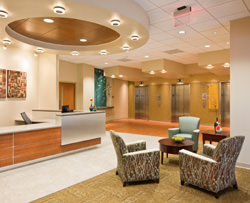The Lighting Practice would like to share the below article published by HKS, Inc. on the current direction of Healthcare Design in America. HKS is a highly respected Architecture, Interior Design, and Structural Engineering firm with locations across the country and internationally. They are involved in a variety of projects and are especially respected in the field of Healthcare Design. We are proud to say we were the lighting designers on HKS’s design team for Capital Health Medical Center – Hopewell which is mentioned in the article.
 Is This a Hospital or a Hotel?
Is This a Hospital or a Hotel?
September 26, 2013
By Brian McFarlane, AIA, Principal, Group Director for Healthcare Development, HKS, Inc. and Rachel Saucier Knox, AIA, LEED AP BD+C, Vice President, Pediatrics Healthcare Practice Leader
HKS hospital designs have been recognized in the media recently for their beauty and comfort including Benjamin Russell Hospital for Children and Capital Health Medical Center, noted in the September 21 article in The New York Times.
While this is a welcome change from hospitals’ longstanding reputation for institutional drabness, some people have questioned whether high design comes at a high price. In fact, quality design is integral to clinical excellence and operational efficiency. By designing smart, project teams can create hospitals that cost less to build, less to operate and help provide higher quality care.
Quality and efficiency are extremely important as the Patient Protection and Affordable Care Act (ACA) heads toward full implementation. The ACA will compel hospitals to provide tangible factors that increase patient satisfaction, as payments will be based, in part, on patient satisfaction surveys. An increase in the number of patients is expected to create a shortage of physicians, requiring hospitals to make the most of doctor-patient interactions. And since the new law will penalize hospitals for excessive readmissions, providers must focus not only on getting patients well, but keeping them well.
Properly sized patient rooms are an excellent example of a patient satisfier with clinical benefits and cost savings. Private rooms reduce infection risk and provide the quiet atmosphere necessary for healing. Family zones within rooms enable family members to stay with the patient 24/7 without interfering with nurses and others on the care team; family involvement can improve patient safety and help prevent readmissions. Sufficient space and privacy allow doctors to maximize the time they spend face-to-face with patients. Standardized layouts are more efficient to build, and they give hospitals the flexibility to adapt a patient unit to a different acuity level without extensive renovation.
To read the full article click here.

